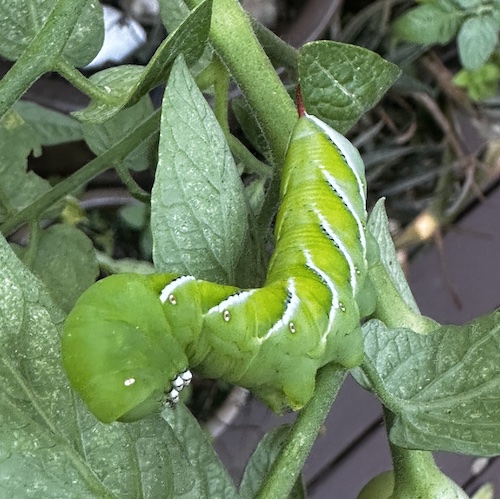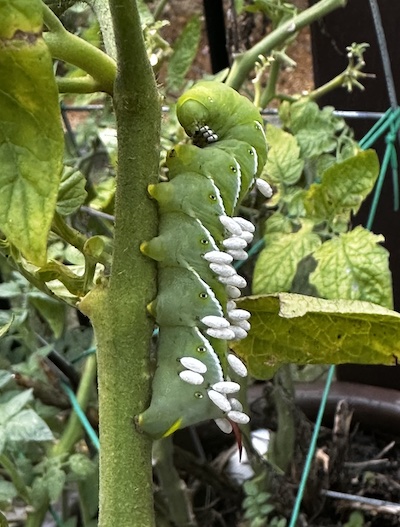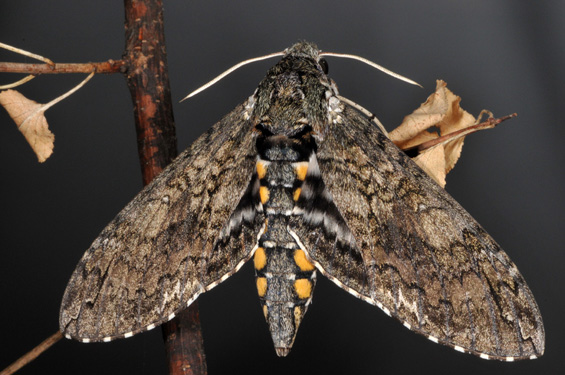Controlling A Tomato Nemesis with Veggie Vengeance
by Christina Tyler Wenks, Fairfax Master Gardener
 Every vegetable gardener dreams for months of harvesting ripe tomatoes still warm from the sun, A hornworm doesn’t have the patience and can defoliate an entire mature plant within a few days, robbing the gardener of fruit and leaving behind frustration and frass.
Every vegetable gardener dreams for months of harvesting ripe tomatoes still warm from the sun, A hornworm doesn’t have the patience and can defoliate an entire mature plant within a few days, robbing the gardener of fruit and leaving behind frustration and frass.
This vegetable gardener’s archenemy has its own natural nemesis. Control can be easy and require no chemicals.
Often disguised among tomato, pepper, potato and eggplant leaves, the larvae of sphinx, hawk or hummingbird moths are green with a distinct “horn” on their tail ends. On a tobacco hornworm (Manduca sexta), the horn is red, while on the tomato hornworm (Manduca quinquemaculata), the horn is dark blue or black. Both species feature white stripes along their sides. Tobacco hornworm stripes have black margins along the white stripes. Tomato hornworm stripes have green margins.
Adult moths are primarily active at night and feed on nectar. Based on chemical cues such as odor detected by antennae, moths select plants for laying spherical greenish-yellow eggs, which are deposited one by one on the undersides of host leaves, and hatch in approximately one week. Hornworm larvae feed for three to four weeks, molt five times and may reach 4 inches (10 cm) in length and one-half inch (4 cm) wide when fully grown.
Control
In a garden setting, manual control is quick, easy and affordable. Tomato hornworms are easy to find because of their large size. Plucking the caterpillar from plants and destroying by dropping into soapy water is effective.
Before defoliation is severe, check plants for tomato hornworms at least twice per week during the summer. Removing weeds reduces the number of sites where moths can lay eggs.

Hornworm with wasp eggs
Hornworms have several natural enemies, including birds and small mammals. Insects such as lacewing and lady beetle larvae consume the eggs and early instar larvae. The paper wasp is another predator that feeds on many types of caterpillars found in gardens.
Parasitic braconid wasps are a common and important natural predator of hornworms. As small as a fly and harmless to humans, braconid wasps lay their eggs inside the body of hornworms. After feeding within the caterpillar body, the wasp larvae eat through the hornworm’s skin and spin cocoons on the caterpillar’s surface. When adult wasps are ready to pupate from cocoon-covered hornworms, tiny wasps escape from the rice-sized cocoons to parasitize other hornworms. Gardeners who are hand-picking hornworms should avoid killing the cocoons of parasitic wasps on the backs of hornworms so adult wasps can emerge, mate, and seek additional hornworm hosts for their eggs.
Managing hornworms
Pesticides are generally not necessary. If other options are not effective or practical, low-risk pesticides include Bacillus thuringiensis (Bt), a naturally-occurring soil bacterium that produces a protein that acts as a fatal endotoxin when ingested by Lepidopteran larvae. Bt is more effective on instar larvae. This product is widely available and safe for use around pollinating insects because Bt must be consumed to be effective. Bt is suitable for use in organic gardens. When using any chemical product, follow label instructions and precautions for safety and suitability of the pest, crop and location.

Hornworm adult
Spinosad is another product derived from a naturally occurring soil-dwelling microorganism that affects the hornworm larva nervous system. Spinosad works for one to two weeks and is toxic to bees when wet.
Insecticidal soap is most effective against small caterpillars, but the product must contact caterpillars directly to be effective.
Physically removing hornworms from veggies is easy and usually the only necessary management. Placing hornworms in a bird feeder could be cathartic for the gardener serving up some veggie vengeance while also supporting the food chain.
- References
- Hornworms in Home Gardens, Eric Day and Theresa A. Dellinger, Dept of Entomology, Virginia Tech, 3104-1551
- Tomato Hornworm, Center for Agriculture, Food and Environment, University of Massachusetts Extension Vegetable Program
- Tobacco Hornworm, Morgan A. Byron and Jennifer L. Gillett-Kaufman, Entomology and Nematology Department, University of Florida
- Tomato Hornworms in home gardens, Jeffrey Hahn and Suzanne Wold-Burkness, College of Food, Agriculture and Natural Resource Sciences, University of Minnesota Extension